1814-1840 Chapter VIII INDUSTRIAL ADVANCE BY 1840
CHAPTER VIII.
INDUSTRIAL ADVANCE BY 1840
During the War of 1812 we had in England an industrial spy, whose campaign there has perhaps accomplished more for the country than all our armies did. It was Francis C. Lowell, of Boston. Great Britain was just introducing the power loom. The secret of structure was guarded with all vigilance, yet Lowell, passing from cotton factory to cotton factory with Yankee eyes, ears, and wit, came home in 1814, believing, with good reason, as it proved, that he could set up one of the machines on American soil. Broad Street in Boston was the scene of his initial experiments, but the factory to the building of which they led was at Waltham. It was owned by a company, one of whose members was Nathan Appleton. Water furnished the motive power.
By the autumn of 1814 Lowell had perfected his looms and placed them in the factory. Spinning machinery was also built, mounting seventeen hundred spindles. English cotton-workers did not as yet spin and weave under the same roof, so that the Lowell Mill at Waltham may, with great probability, be pronounced the first in the world to carry cloth manufacture harmoniously through all its several successive steps from the raw stuff to the finished ware.
From this earliest establishment of the power-loom here, the cotton-cloth business strode rapidly forward. Fall River, Holyoke, Lawrence, Lowell, and scores of other thriving towns sprung into being. Every year new mills were built. In 1831 there were 801; in 1840, 1,240; in 1850, 1,074. Henceforth, through consolidation, the number of factories decreased, but the number of spindles grew steadily larger. This rise of great manufacturing concerns was facilitated by a new order of corporation laws. There had been corporations in the country before 1830, as the Waltham case shows; but the system had had little evolution, as incorporation had in each case to proceed from a special legislative act.
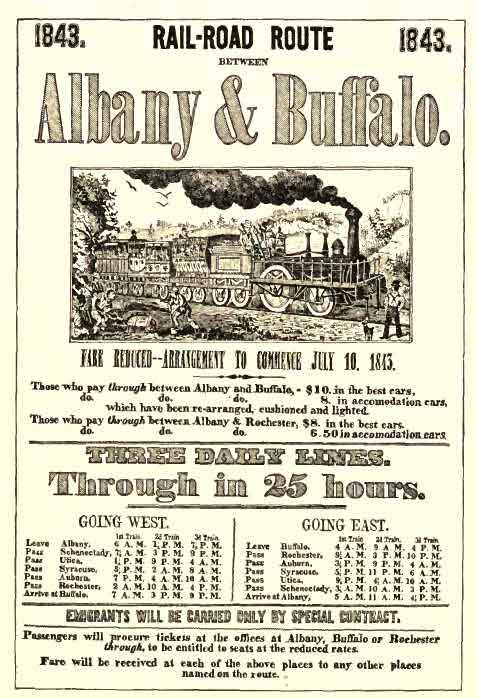
From an Old Time-table. (Furnished by the ABC Pathfinder Railway Guide.)
In 1837 Connecticut passed a statute making this unnecessary and enabling a group of persons to become a corporation on complying with certain simple requirements. New York placed a similar provision in its constitution of 1846. The Dartmouth College decision of the United States Supreme Court in 1819, interpreting an act of incorporation as a contract, which, by the Constitution, no State can violate, still further humored and aided the corporation system.
In 1816 the streets of Baltimore were lighted with gas. A gas-light company was incorporated in New York in 1823. Not till 1836, however, did the Philadelphia streets have gas lights. The first savings-banks were established in Philadelphia and Boston in 1816. Baltimore had one two years later. Portable fire-proof safes were used in 1820. The Lehigh coal trade flourished this year, and also the manufacture of iron with coal. The whale fishery, too, was now beginning. The first factory in Lowell started in 1821.
In 1822 there was a copper rolling mill in Baltimore, the only one then in America, and Paterson, N. J., began the manufacture of cotton duck. Patent leather was made in the United States by 1819. In 1824 Amesbury, Mass., had a water-power manufactory of flannel. The next year the practice of homoeopathy began in America, and matches of a rude sort were displacing the old tinder-box.

Trial between Peter Cooper's Locomotive "Tom Thumb"
and one of Stockton's and Stokes' Horse Cars.
From "History of the First Locomotive in America."
The next year after this Hartford produced axes and other edged tools. Lithography, of which there had been specimens so early as 1818, was a Boston business in 1827. Pittsburgh manufactured damask table linen in 1828. The same year saw paper made from straw, and planing machinery in operation. The insuring of lives began in this country in 1812.
The first figured muslin woven by the power-loom in America, and perhaps in the world, was produced at Central Falls, R. I., in 1829. Calico printing began at Lowell the same year, also the manufacture of cutlery at Worcester, of sewing-silk at Mansfield, Conn., of galvanized iron in New York City. With the new decade chloroform was invented, in 1831, being first used as a medicine, not as an anaesthetic. Reaping machines were on trial the same year, and three years later machine-made wood screws were turned out at Providence. About the same time, 1832, pins were made by machinery, hosiery was woven by a power-loom process, and Colt perfected his revolver.
In 1837 brass clocks were put upon the American market, and by 1840 extensively exported. Also in 1837 Nashua was making machinists' tools. By 1839 the manufacture of iron with hard coal was a pronounced success. In 1840 daguerreotypes began to appear. Steam fire-engines were seen the next year.
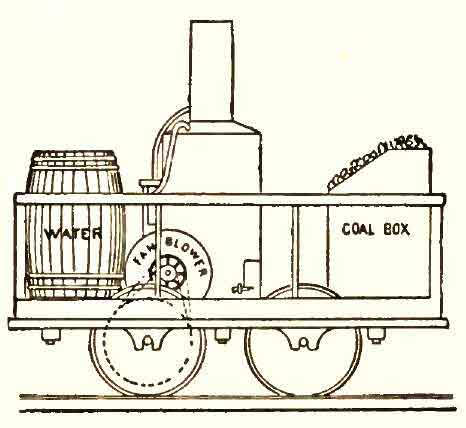
Peter Cooper's Locomotive, 1829.
So early as 1816 the New York and Philadelphia stages made the distance from city to city between sun and sun. The National Road from Cumberland was finished to Wheeling in 1820, having been fourteen years in construction and costing $17,000,000. It was subsequently extended westward across Ohio and Indiana. It was thirty-five feet wide, thoroughly macadamized, and had no grade of above five degrees.
Over parts of this road no less than 150 six-horse teams passed daily, besides four or five four-horse mail and passenger coaches. In Jackson's time, when for some months there was talk of war with France and extra measures were thought proper for assuring the loyalty of Louisiana, swift mail connections were made with the Mississippi by the National Road. Its entire length was laid out into sections of sixty-three miles apiece, each with three boys and nine horses, only six hours and eighteen minutes being allowed for traversing a section, viz., a rate of about ten miles an hour. Great men and even presidents travelled by the public coaches of this road, though many of them used their own carriages. James K. Polk often made the journey from Nashville to Washington in his private carriage. Keeping down the Cumberland River to the Ohio, and up this to Wheeling, he would strike into the National Road eastward to Cumberland, Md.
WHIGS AND DEMOCRATS
He came thus so late as 1845, to be inaugurated as President; only at this time he used the new railway from Cumberland to the Relay House, where he changed to the other new railway which had already joined Baltimore with Washington.
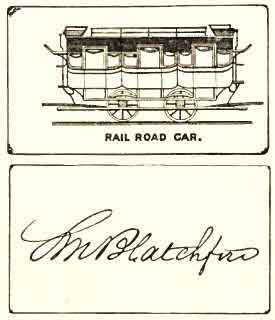
The first omnibus made its appearance in New York in 1830, the name itself originating from the word painted upon this vehicle. The first street railway was laid two years later. The era of the stage coach was at this time beginning to end, that of canals and railroads opening.
Yet in the remoter sections of the country the old coach was destined to hold its place for decades still. Where roads were fair it would not uncommonly make one hundred miles between early morning and late evening, as between Boston and Springfield, Springfield and Albany.
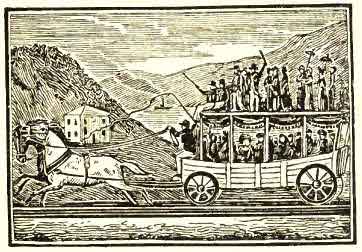
Baltimore & Ohio Railroad, 1830.
So soon as available the canal packet was a much more easy and elegant means of travel. The Erie Canal was begun in 1817, finished to Rochester in 1823, the first boat arriving October 8th. The year 1825 carried it to Buffalo.
142 WHIGS AND DEMOCRATS
The Blackstone Canal, between Worcester and Providence, was opened its whole length in 1828; the next year many others, as the Chesapeake and Delaware, the Cumberland and Oxford in Maine, the Farmington in Connecticut, the Oswego, connecting the Erie Canal with Lake Ontario, also the Delaware and Hudson, one hundred and eight miles long, from Honesdale, Pa., to Hudson River. The Welland Canal was completed in 1830.
Salt-water transportation had meantime been much facilitated by the use of steam. It had been thought a great achievement when, in 1817, the Black Ball line of packet ships between New York and Liverpool was regularly established, consisting of four vessels of from four hundred to five hundred tons apiece. But two years later a steamship crossed the Atlantic to Liverpool from Savannah. It took her twenty-five days--longer than the time in which the distance often used to be accomplished under sail. In 1822 there was a regular steamboat between Norfolk and New York, though no steamboat was owned in Boston till 1828.
INDUSTRIAL ADVANCE BY I840
The Atlantic was first crossed exclusively by steam-power in 1838, and the first successful propeller used in 1839. The last-named year also witnessed the beginning of a permanent express line between Boston and New York, by the Stonington route. The next year, the Adams Express Company was founded, doing its first business between these two cities over the Springfield route, in competition with that by the Stonington.
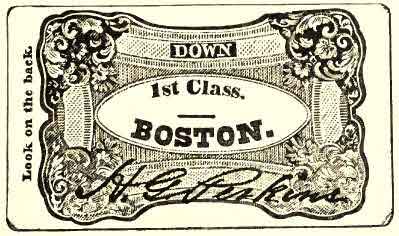
But all these improvements were soon to be overshadowed by the work of the railway and locomotive. The first road of rails in America was in the Lehigh coal district of Pennsylvania. Its date is uncertain, but not later than 1825.
In 1826, October 7th, the second began operation, at Quincy, Mass., transporting granite from the quarries to tide-water, about three miles. This experiment attracted great attention, showing how much heavier loads could be transported over rails than upon common roads, and with how much greater ease and less expense ordinary weights could be carried. The same had been demonstrated in England before. Locomotives were not yet used in either country, but only horse-power. The conviction spread rapidly that not only highway transportation but even that by canals would soon be, for all large burdens, either quite superseded or of secondary importance. In 1827 the Maryland Legislature chartered a railroad from Baltimore to Wheeling. The projectors, though regarding it a bold act, promised an average rate between the two cities of at least four miles per hour. Subscriptions were offered for more than twice the amount of the stock.
The Massachusetts Legislature the same year appointed commissioners to look out a railway route between Boston and Hudson River. Also in this year a railway was completed at Mauch Chunk, Pa., for transporting coal to the landing on the Lehigh. The descent was by gravity, mules being used to haul back the cars.
In most country parts, the new railway projects encountered great hostility. Engineers were not infrequently clubbed from the fields as they sought to survey. Learned articles appeared in the papers arguing against the need of railways and exhibiting the perils attending them. When steam came to be used, these scruples were re-enforced by the alleged danger that the new system of travel would do away with the market for oats and for horses, and that stage-drivers would seek wages in vain.
The first trip by a locomotive was in 1828, over the Carbondale and Honesdale route in Pennsylvania. The engine was of English make, and run by Mr. Horatio Allen, who had had it built.
VOL. III.--10
This was a year before the first steam railroad was opened in England. July 4, 1828, construction upon the Baltimore & Ohio Railroad was begun. It, like the other early roads, was built of stone cross-ties, with wooden rails topped with heavy straps of iron.
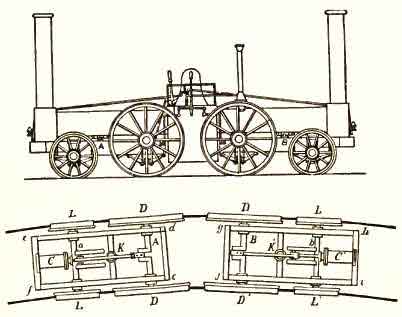
The "South Carolina," 1831, and plan of its running gear.
Such ties were soon replaced by wooden ones, as less likely to be split by frost, but the wooden rail with its iron strap might be seen on branch lines, for instance, between Monocacy Bridge and Frederick City, Md., so late as the Civil War.
The first railroad for passengers in this country went into operation between Charleston and Hamburg, S. C., in 1830. The locomotive had been gotten up in New York, the first of American make. It had four wheels and an upright boiler. This year the railroad between Albany and Schenectady was begun, and fourteen miles of the Baltimore & Ohio opened for use.
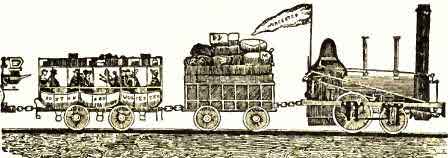
Boston & Worcester Railroad, 1835.
In 1831 Philadelphia was joined to Pittsburgh by a line of communication consisting of a railway to Columbia, a canal thence to Hollidaysburg, another railway thence over the Alleghanies to Johnstown, and then on by canal. The railway over the mountains consisted of inclined planes mounted by the use of stationary engines. It is interesting to notice the view which universally prevailed at first, that the locomotive could not climb grades, and that where this was necessary stationary engines would have to be used.
Not till 1836 was it demonstrated that locomotives could climb. Up to the same date, also, locomotives had burned wood, but this was now found inferior to coal, and began to be given up except where it was much the cheaper fuel.
From 1832 the railway system grew marvellously. The year 1833 saw completed the South Carolina Railroad between Charleston and the Savannah River, one hundred and thirty-six miles. This was the first railway line in this country to carry the mails, and the longest continuous one then in the world. Two years later Boston was connected by railway with Providence, with Lowell, and with Worcester, Baltimore with Washington, and the New York & Erie commenced. In 1839 Worcester was joined to Springfield in the same manner, and in 1841 a passenger could travel by rail from Boston to Rochester, changing cars, however, at least ten times.


